How To Make Real Crystals

I dear growing crystals. It'south a smashing family activity, and a very cool science experiment. Yous tin can brand beautiful ones from sugar, alum, or even table common salt.
Merely one of the easiest and near beautiful crystal you lot can grow is actually a mutual fertilizer. It's called monoammonium phosphate (MAP) and it gives plants the nitrogen and phosphorus they demand.
MAP is inexpensive, non-toxic and under the right atmospheric condition, grows into stunning crystal clusters. In fact, it's the ingredient within most crystal growing kits. More surprisingly, these crystals are besides grown industrially and have military and infinite applications (more on that later).
There are many guides on growing crystals online, but none of them go into bang-up detail and they don't show you just how stunning these crystals can be.
I've been growing crystals for three years now, and I've learnt a few tricks to become great crystals.
 Some crystals I grew on a minor co-operative overnight. Later on, I'll show y'all how I made it.
Some crystals I grew on a minor co-operative overnight. Later on, I'll show y'all how I made it.
In this article, I'll comprehend the best crystals I've grown, share the verbal procedure I used, and testify you beautiful specimens grown by other hobbyists.
Growing crystals at abode
The thought is simple. Deliquesce the MAP powder in water until information technology is saturated. Wait for seed crystals to course, and harvest them after a 24-hour interval. Transfer the seed crystals to a bigger container and allow them grow.
I'll go through each step with you.
Materials
For growing crystals, you'll need:
- A packet of MAP fertilizer
- A pot to dissolve the pulverisation
- A jar to grow the crystals in
- A filter funnel/coffee filter
- Some thread/fishing line
- A pocket-size dish
- A spoon
- A pencil
You can find monoammonium phosphate (MAP) in gardening stores every bit a fine white pulverisation. Sometimes, information technology's as well called ammonium dihydrogen phosphate (ADP). If you tin't find information technology, yous tin can order some online.

How much MAP yous need depends on how big you want to abound the crystal. 500g is enough to grow a crystal the size of your palm. Theoretically, in that location is no limit to how big you can grow them, provided you have enough solution and a sufficiently large container.
 A massive 6.5-pound crystal grown by Terry Bartlett, a long time crystal growing enthusiast.
A massive 6.5-pound crystal grown by Terry Bartlett, a long time crystal growing enthusiast.
 Some insanely impressive MAP crystals by Spanish artist Isabel Lopez.
Some insanely impressive MAP crystals by Spanish artist Isabel Lopez.
This guide volition be divide into 6 sections:
- Preparing the solution
- Growing seed crystals
- Growing big crystal clusters
- Growing perfect single crystals
- Growing crystals on objects
- Troubleshooting & FAQ
All the steps are very easy to follow.
Preparing the solution
Technically, MAP is a type of salt. Similar tabular array salt, it dissolves in water. At room temperature, 100 mL of h2o can dissolve nigh 40 g of MAP. Hot h2o can dissolve more than.
Permit's start. First, fix some hot water. For every 100 mL of water, dissolve 60 g of MAP. Stir until all the powder dissolves. I'one thousand using a chalice, only you don't have to.

Filter the solution into a jar using a coffee filter to get rid of grit and impurities. So, go out the solution to cool downward.
Growing seed crystals
Once absurd, our solution is ready. At present, nosotros want to start growing small crystals to act as "seeds" that volition class bigger ones in the futurity.
First, sprinkle a pinch of MAP powder into the solution, and stir it vigorously. After most 30 seconds, you lot should see a lot of extra crystalline dust forming. This is exactly what nosotros want.
 The dust is actually made of thousands of microscopic crystals that formed when you disturbed the supersaturated solution.
The dust is actually made of thousands of microscopic crystals that formed when you disturbed the supersaturated solution.
Then, get out the jar solitary for 1-2 hours.
When you lot come dorsum, yous'll find that the dust has formed crystals! Also, in that location might exist some small crystals floating on the surface of the solution.

Groovy.
Give them some fourth dimension to grow.
The next day, the crystals should await like this:
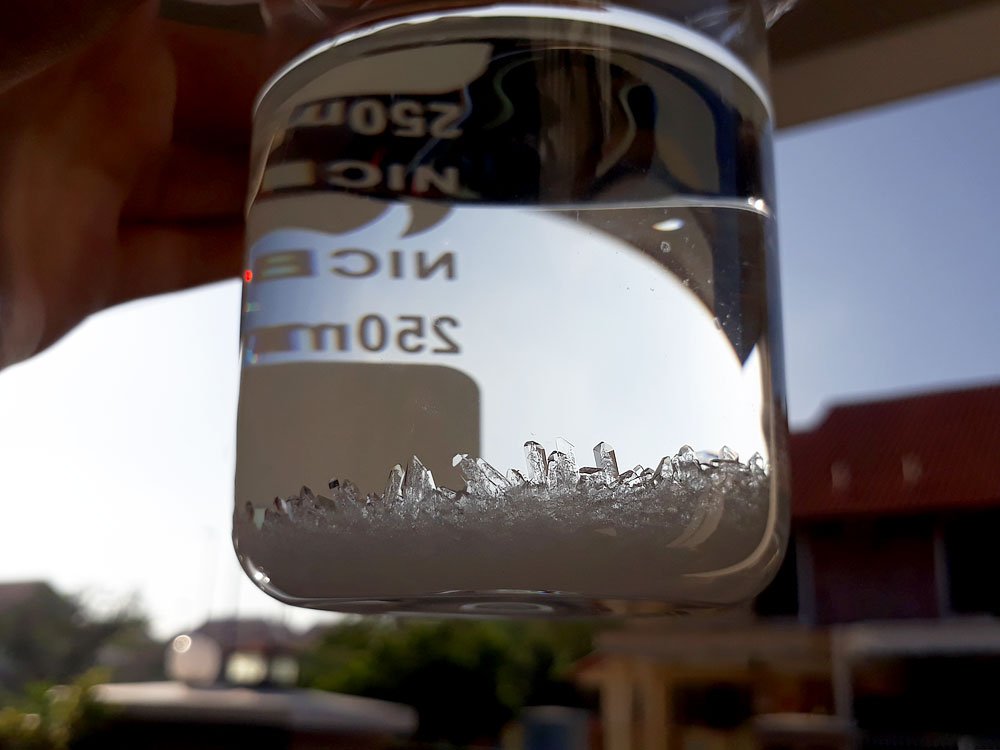
Pour the leftover solution into some other container. Afterward that, remove the chunk of crystals at the bottom of the jar. If it's stuck, put the jar confront down and knock hard to make it come loose. It'southward no large deal if the chunk breaks apart.
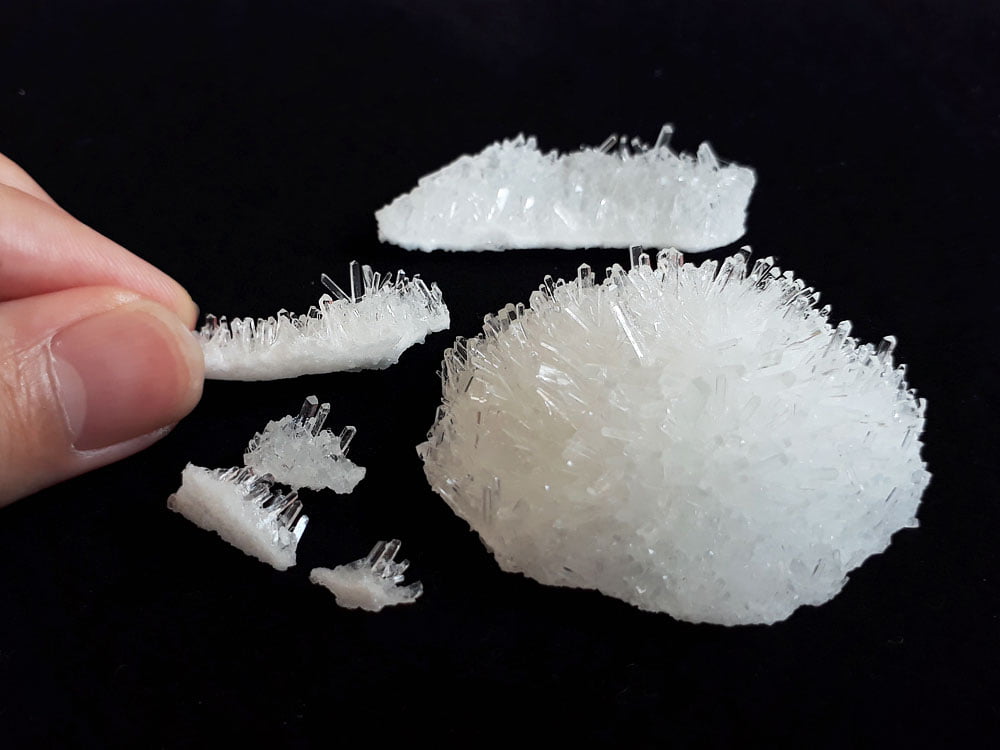
Now that you have an array of modest seed crystals, it's fourth dimension to grow bigger ones!
Growing big crystal clusters
Don't discard the leftover solution. Information technology'south perfect for this footstep.
But what if you don't take enough solution left?
Piece of cake. Make more than.
Just this time, we're making a growing solution. This solution should be less full-bodied than the solution nosotros used to abound seed crystals. Growing crystals from this solution makes them clearer and college in quality.
Then, you lot want to deliquesce 45 g of MAP per 100 mL of h2o. Similar before, stir until all the powder dissolves.
At this betoken, I'd also like to teach you how to control the shape of the crystals. By default, MAP forms thick prismatic crystals. When you lot brand the solution more than acidic, the crystals resemble abrupt, pointy spikes.
 This seed crystal was grown from a more acidic solution. As a event, the spikes are longer and sharper.
This seed crystal was grown from a more acidic solution. As a event, the spikes are longer and sharper.
A very easy mode to increase the acerbity is to add alum, used in blistering and water purification. It can be found at the grocery store, or bought online.

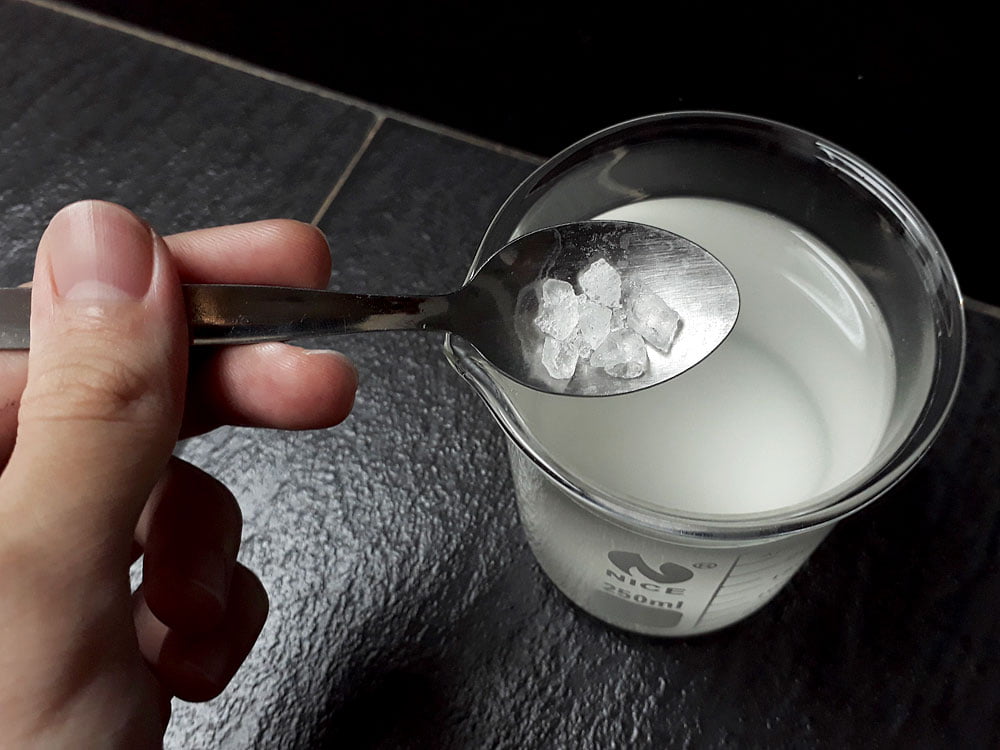 Depending on how spiky you desire your crystals, add anywhere between 0 and i gram of alum per 100 mL water.
Depending on how spiky you desire your crystals, add anywhere between 0 and i gram of alum per 100 mL water.
Dissolve the alum in the MAP solution. Like before, filter the solution and wait for information technology to cool.
So, cascade the solution into a dish, and gently identify a seed crystal in the heart. Since you lot have and then many seed crystals, you might want to practice a few of these at once.

This volition be your growing setup. Leave it in a sheltered area, somewhere that isn't directly exposed to the wind or fan.
Depending on your weather condition, the seed crystals will start growing inside a few hours, and exist noticeably bigger within a twenty-four hours. Afterwards three days, this is what the crystal in the picture above looks similar:

Isn't information technology amazing, how you tin can just grow crystals at dwelling?
To give you an idea of how calculation alum affects the shape of the crystals, hither are some pictures of MAP crystals I grew using the aforementioned setup.
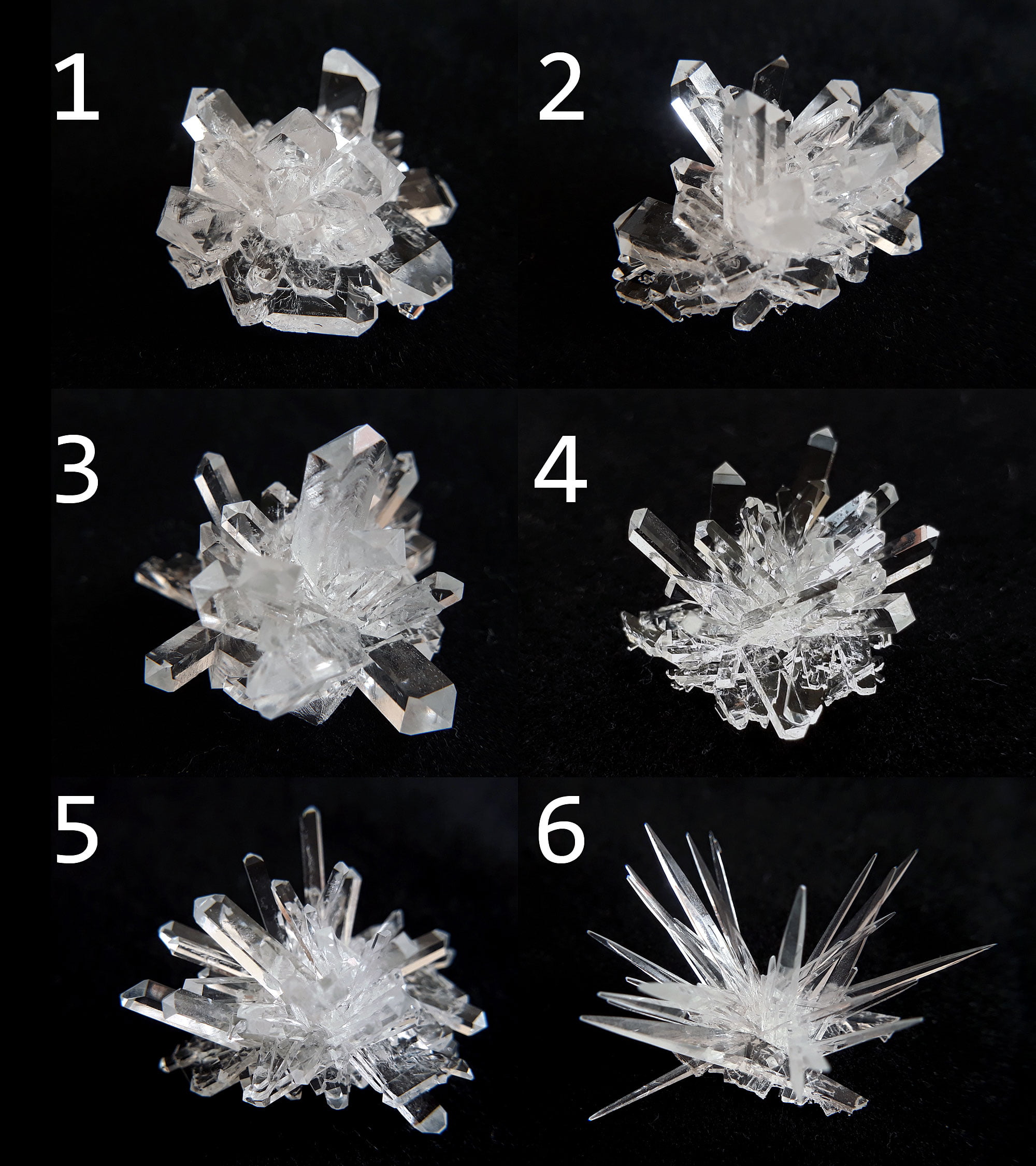 Crystals grown with (0, 0.25, 0.5, 0.75, 1 & 1.25) thou alum / 100 mL water over 3-6 days.
Crystals grown with (0, 0.25, 0.5, 0.75, 1 & 1.25) thou alum / 100 mL water over 3-6 days.
1 and 2 are quite lumpy, with few singled-out crystals. Their number and length greatly increase as more alum is added.
Afterward a few days, your crystals should be decently sized. Select the most cute ones, and transfer them to a bigger container filled with the aforementioned growing solution (45 g MAP / 100 mL water) and the desired amount of alum.
Identify the crystal inside, and expect for it to grow big!

Smaller crystals like to course at the side. They compete with your principal crystal for growth, but don't bother removing them. Attempting to practice and so only causing crystal dust to form and stick everywhere.
Instead, either a) blow them away with a dropper or b) pour the solution to a new container and motility the main crystal there.
 Observe how lots of smaller crystals like to class alongside the main crystal. There'due south a clear band in the middle because I blew them away with a dropper.
Observe how lots of smaller crystals like to class alongside the main crystal. There'due south a clear band in the middle because I blew them away with a dropper.
In one case y'all're satisfied with their size, you tin harvest and dry out them on a newspaper towel. Don't wash them though, because they will slowly deliquesce in h2o.
Hither'due south my crystal later on 3 weeks:
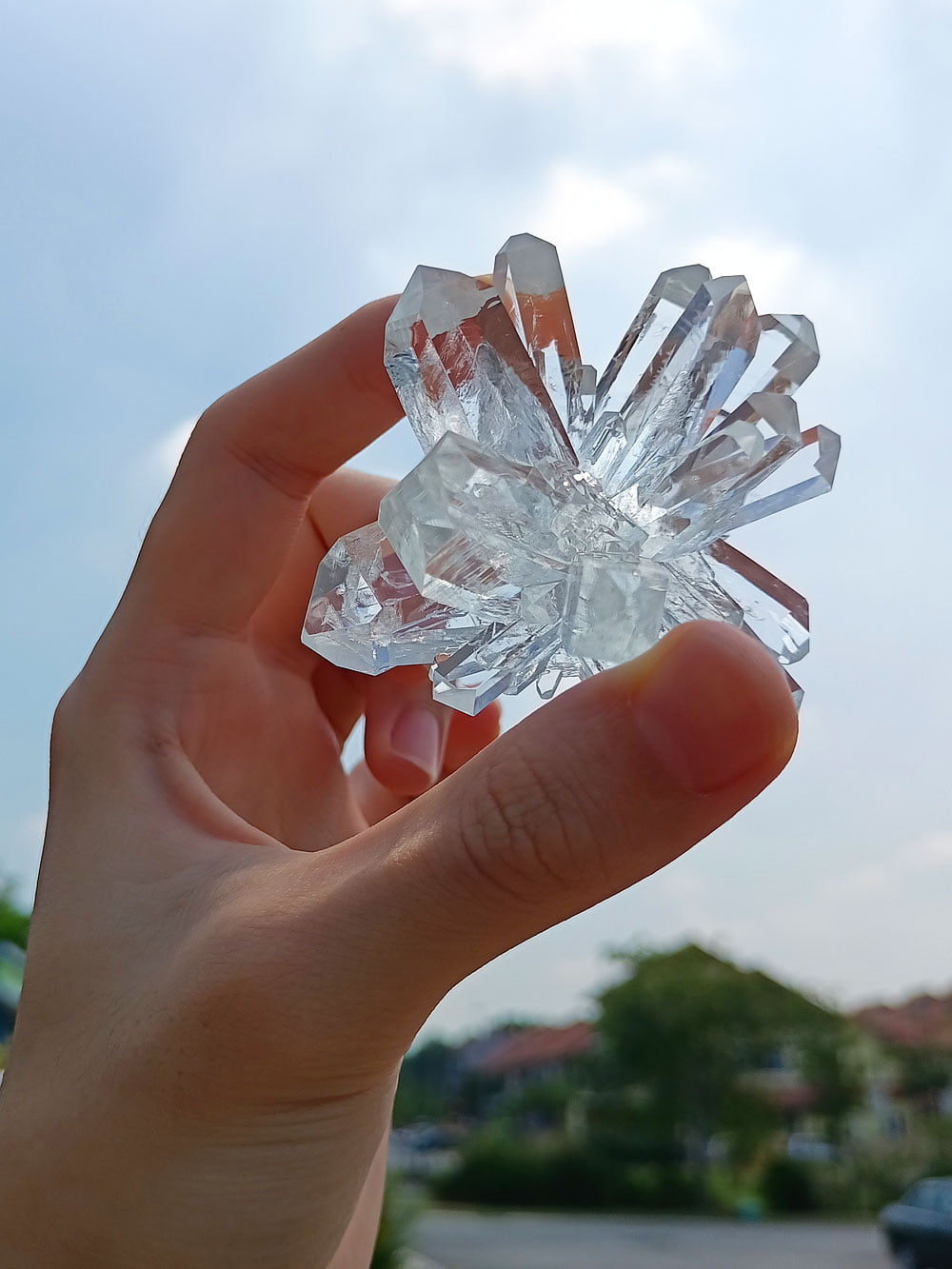
A star shaped crystal grown with more alum over the grade of iii weeks:

An fifty-fifty spikier one, taking only 1 calendar week to grow:
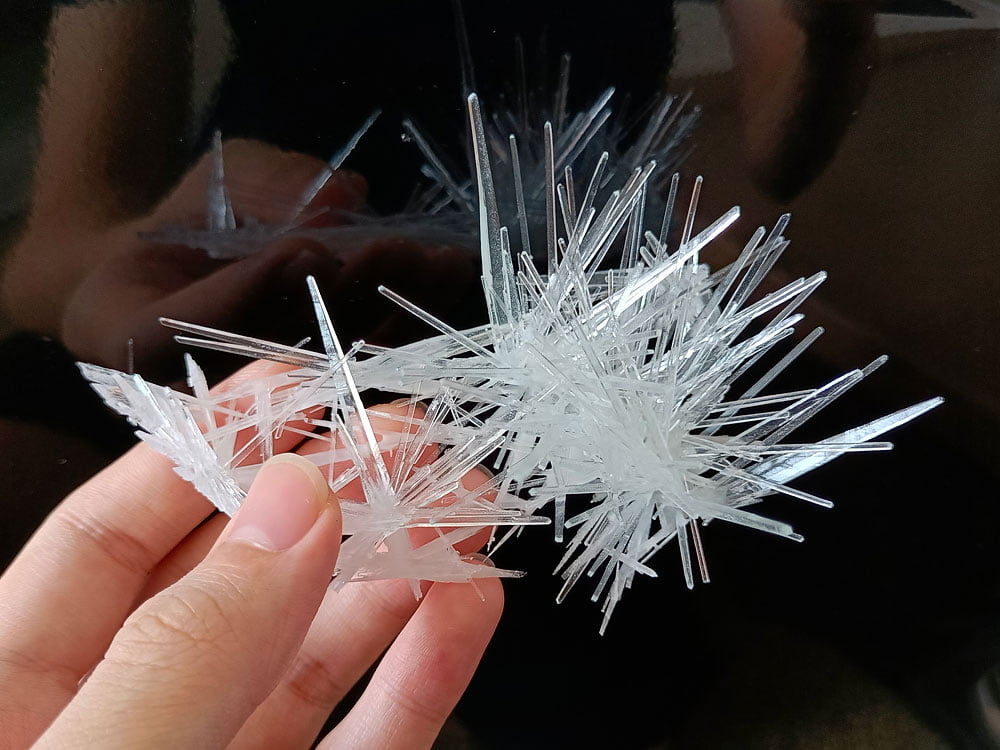
Super cool.
Note that the more alum is added, the faster the crystals appear to grow. Really they abound at the same rate; sharper spikes grow longer faster, simply individually they incorporate less crystal mass.
Growing crystals at the bottom of the container means they will ever exist apartment on the underside. If you desire to grow more symmetrical clusters, you tin hang the seed crystals using a sparse nylon line-fishing line.

The crystals are quite hardy, and it's safe to handle them. Merely the crystals on very spiky specimens are sharp and much more fragile – so exist conscientious.
If you're a parent, watch as your kid falls in dearest with science. If y'all're a kid, prove them off, and you'll automatically become the coolest child in class.
Just wait! There's more than to it.
Growing perfect unmarried crystals
So far, we've been growing crystals in the form of clusters.
MAP can as well course single crystals that wait like gems. Growing them will require a different approach. Here'due south how:
Prepare some other growing solution. Cascade it into a dish. You don't need to add any pulverization or seed crystals. Just leave information technology in a sheltered place for a twenty-four hour period or two.
You should find some articulate, individual crystals start to course.
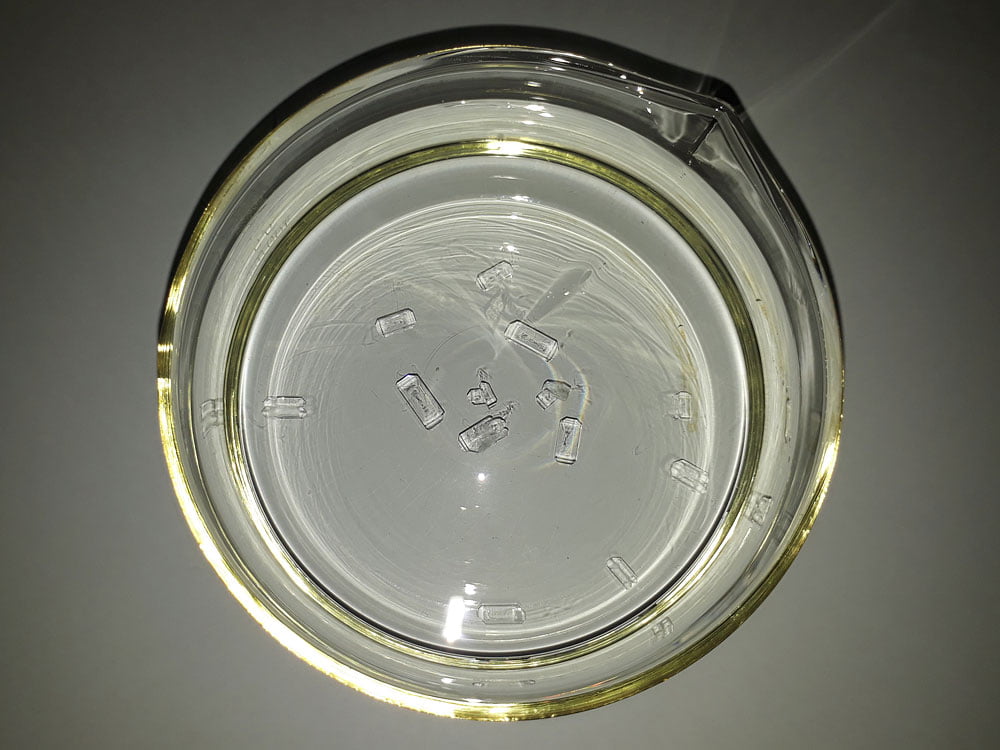
Equally they get bigger, they volition start to grow into each other, which is bad.
So, we want to isolate the crystals by hanging them with a fishing line. Pick them out with a pair of tweezers and tie them onto the line. Necktie the other stop to a stick.
And here are the results:

Like earlier, adding alum will make the crystals spikier. Check out this super sharp needle, grown from a solution with ane 1000 alum / 100 mL water.
 Perfectly balanced, as all things should exist.
Perfectly balanced, as all things should exist.
And this cute star, consisting a pair of single crystals grown into each other.
 They even have a infant.
They even have a infant.
Y'all might have noticed that these crystals have imperfections on their surface. You can reduce these flaws by growing them under more stable conditions, merely the main consequence is considering the MAP fertilizer isn't pure.
To get pure MAP, you lot need to buy lab or reagent grade monoammonium phosphate, which is more than expensive. Then the crystals volition have perfectly flat edges.
 Some very pure MAP crystals I grew.
Some very pure MAP crystals I grew.
In fact, we're not the only ones growing crystals.
MAP crystals are grown industrially to exist used in electronics and optics. They also accept piezoelectric properties, which means that they accumulate electric charge when hit. It was fifty-fifty the subject of a 1963-1965 crystal research project by DARPA, and massive unmarried crystals of pure MAP are grown by the National Ignition Facility to be used in lasers.
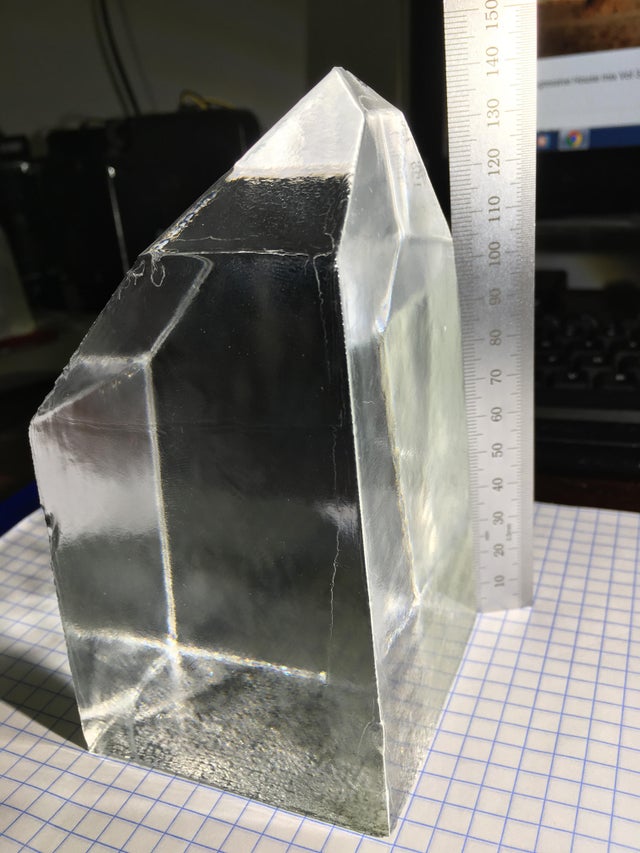
Here'southward a picture of one of those crystals from the DARPA project, provided by Reddit user u/tlbmds who obtained it from an estate sale. His mail contains more information.
Growing crystals on objects
In this section, we'll be growing crystals on objects.
First, select something that you desire to crystallize. Ideally, information technology should be crude, and take some bigger features. Stuff similar rocks, branches and sculptures. Don't choose fragile objects with fine features like dandelions. Those features volition not be preserved.

Now, prepare 2 solutions, i large and one small, with concentrations 50 g and lx g MAP / 100 mL water respectively.
Stir, filter and look for it to absurd.
 Two solutions. Nutrient coloring has been added to the bigger batch.
Two solutions. Nutrient coloring has been added to the bigger batch.
Sprinkle some MAP powder into the smaller jar. Stir vigorously to grade the crystalline dust. Then, immediately poke your object into the jar to let some of the dust stick on it. Let it stay there for virtually 30 seconds.

Then, remove it from the small jar, and immerse information technology into the large jar – and you're done.
The crystal grit should commencement forming crystals on the object. Inside a few hours, my co-operative looked like this:
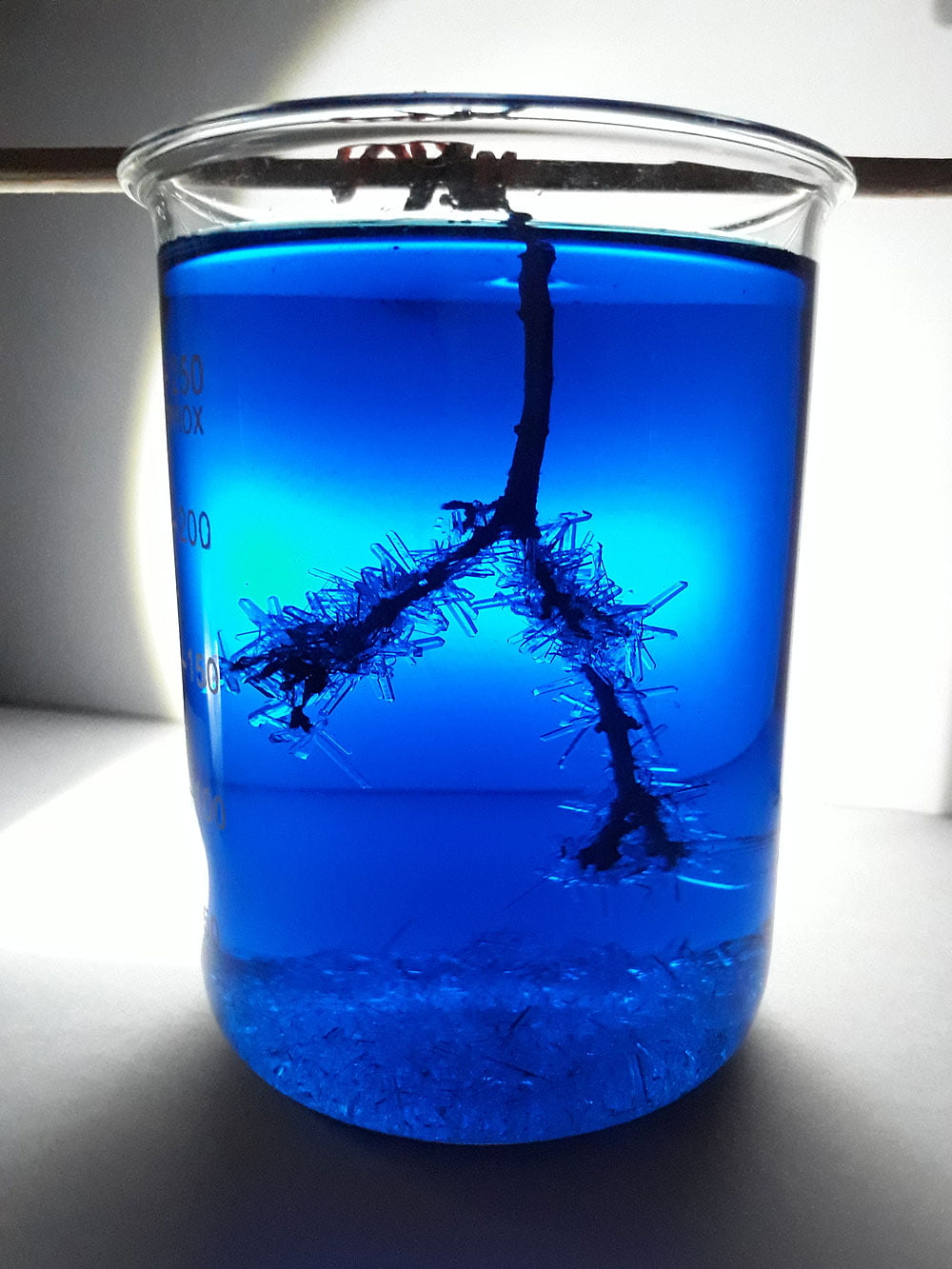
The side by side day:

Get creative with this process. Hither are some ideas:
- Attempt solutions of different concentrations.
- Try crystallizing smoothen surfaces.
- Effort gluing the seed crystals on the object.
- Try not using seed crystals
- Endeavor immersing the object in stages.
- Endeavour growing crystals from a solution without alum, then place them in a solution with alum. And vice versa. This i is very interesting. What exercise you observe?
Here are some beautiful specimens from the crystal growing community.
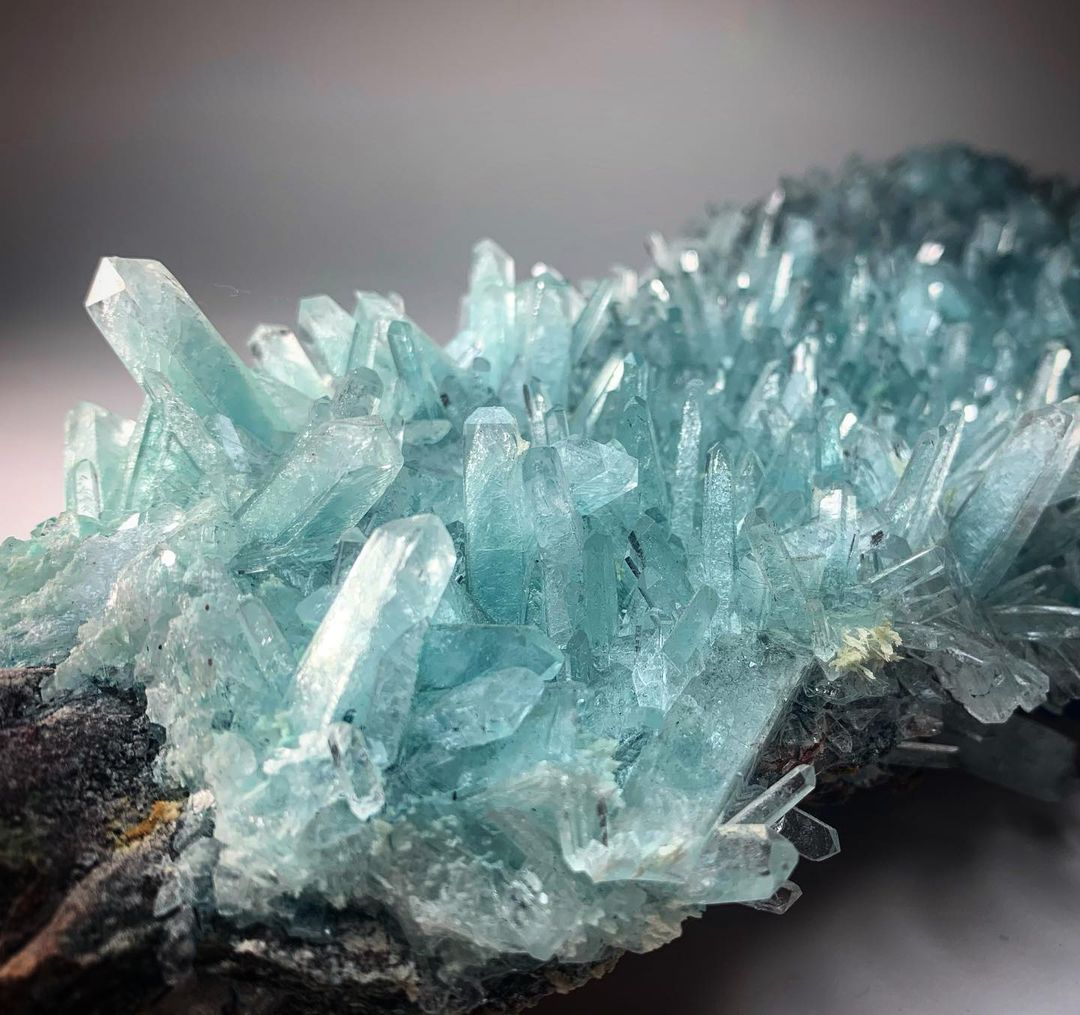 Ice blue crystals on ruby pine bark past artist Stefan Herda. Yous tin see more of his creations on his website.
Ice blue crystals on ruby pine bark past artist Stefan Herda. Yous tin see more of his creations on his website.
 A crystallized cicada by Adrienne DeLoe, who specializes in preserving insects through fine art.
A crystallized cicada by Adrienne DeLoe, who specializes in preserving insects through fine art.
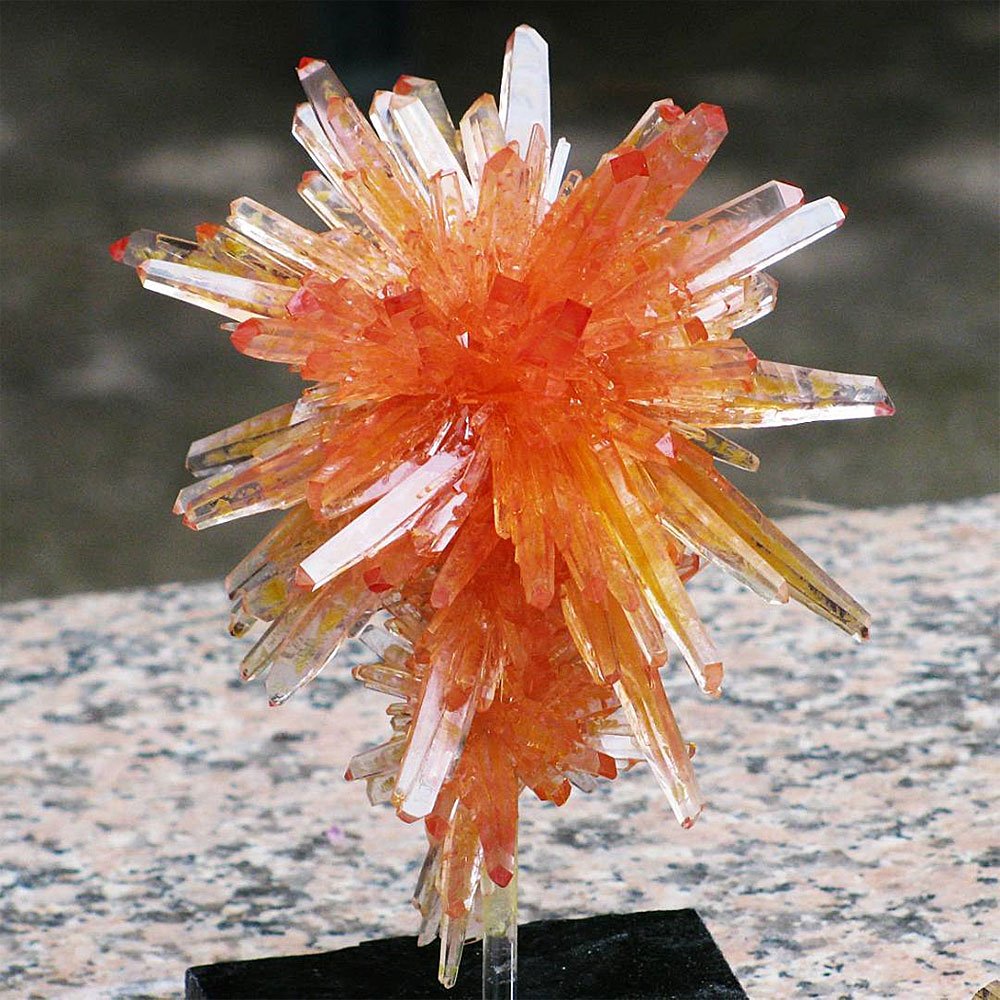 Another gorgeous cluster of orange crystals by Isabel Lopez.
Another gorgeous cluster of orange crystals by Isabel Lopez.
Troubleshooting & FAQ
In that location are a few places where things might get wrong. All of them are easy fixes. They also use to crystal growing kits that you buy at the store.
-
Why are crystals not forming?
Effort dropping a compression of MAP powder into the solution and see if crystals class. Sometimes they need something to kick outset their growth. Otherwise, it's possible that your solution is non concentrated enough. Either reheat the solution and add more MAP, or pour it into a flat dish to speed up evaporation.
-
Why did my crystals deliquesce?
This occurs when you lot put an existing crystal into an undersaturated solution (same problem every bit above). I recommend preparing large batches of solution at once, so that you don't have to keep worrying nearly this issue.
-
Why are my crystals not transparent?

The crystals grew too quickly. The supposedly perfect crystal lattice structure contains lots of defects as a event. Your solution was probable too saturated. Reduce the concentration of the growing solution from 45 to 40 thou MAP / 100 mL water, or fifty-fifty lower (if you live in a cold climate).
-
Why practise my crystals look like an ugly clump?
Aforementioned problem equally above. Likewise, make sure the solution does not become besides low until it exposes the crystal to the air. Stop growing or add more solution earlier this happens.
-
What is this weird crust creeping up my container?
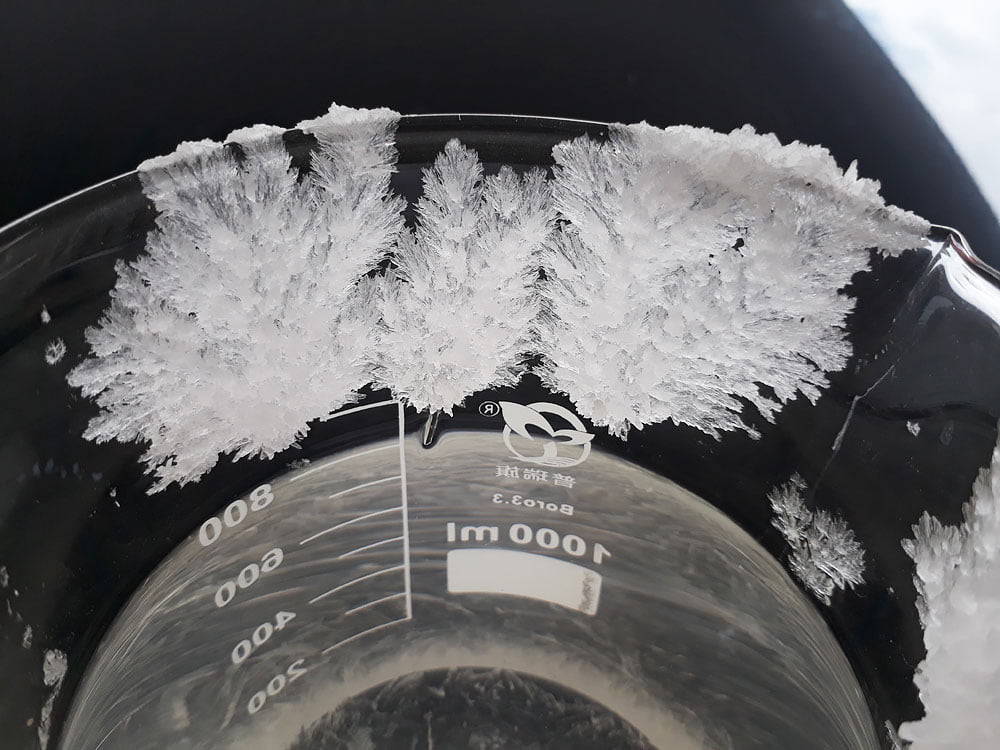
Air motion causes crystals to course above the surface, on the walls of the container. It then sucks up more solution, growing upwards. This result seems to increment with the add-on of more alum.
Aside from slowing down evaporation, there's zip much yous tin exercise virtually it. Just pour the solution into some other container and continue growing. As well, once yous stop freaking out and take a closer await, they're kinda beautiful.
-
Why are crystals not sticking to the object?
Your solution is not supersaturated enough. If the 60 g MAP / 100 mL nucleation solution doesn't work, become for 70 chiliad. If it still doesn't work, the surface of your object is probably as well smoothen.
-
What is the recommended corporeality of alum to add?
It depends on your sense of taste. Only apply less alum (< 0.25 g alum / 100 mL water) if you want super clear single crystals, and use more alum (> 0.five g alum / 100 mL water) if y'all want well defined crystal clusters. Doing the opposite will encourage the growth of jagged single crystals and formless white clumps respectively.
-
Why did white stuff grade afterward calculation alum?
Your h2o / MAP fertilizer likely contains impurities. 1 of the uses of alum is to remove impurities from water past precipitating them out. Information technology's annoying, simply nothing to worry most. Filter information technology away, and continue growing crystals.
-
What is the outcome with food coloring?
It's tricky to dye the crystals. The food coloring you use might react with the solution in unexpected ways. My purple nutrient coloring turned blueish in the solution. I tin can't give much advice hither, because every brand of food coloring is dissimilar. I've heard of people using vegetable carbon, cochineal, even highlighter ink. Feel gratuitous to experiment, and remember to stay prophylactic.
-
Can I make jewelry with these crystals?
No. The crystals are too brittle and cannot exist polished. They have a Mohs hardness of around 3. They also dissolve in water. You wouldn't want a water soluble gem to exist a symbol of everlasting love, exercise you?
Blast polish gives an additional layer of protection. Some people have suggested sealing information technology in epoxy resin. I oasis't tried information technology before, just it might piece of work. Let me know if information technology does.
Being naturally air stable, they do make for good decorations.
-
What other crystals can I grow?
After growing crystals for years, I'grand constantly amazed by this hobby. I recommend trying out alum (aye, alum by itself tin can abound into stunning octahedrons) or sugar. Or take a await at how to abound sodium chloride crystals.
***
That's all for this guide. If you enjoyed it, share information technology with your friends! If yous have whatsoever questions, experience complimentary to comment or transport me a bulletin. I'd love to accept a conversation.
Subscribe to my newsletter if you want to see more guides like this.
And equally always, happy growing.
Source: https://crystalverse.com/growing-crystals/
Posted by: wattshaved1952.blogspot.com

0 Response to "How To Make Real Crystals"
Post a Comment